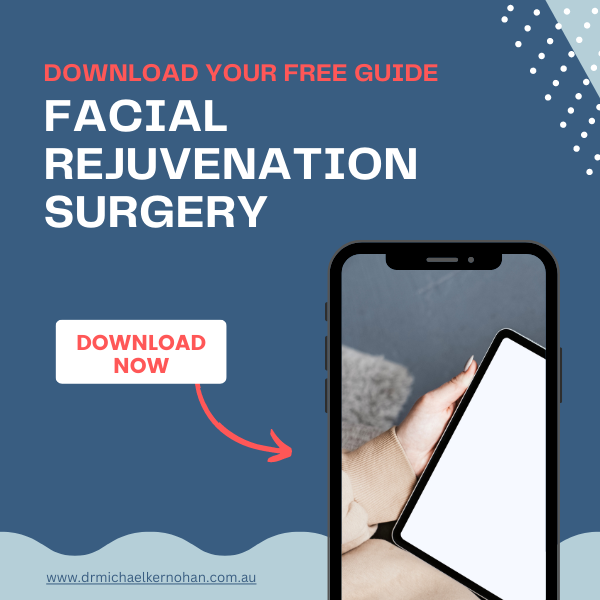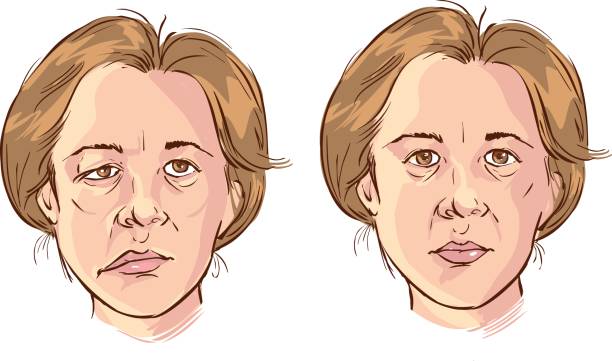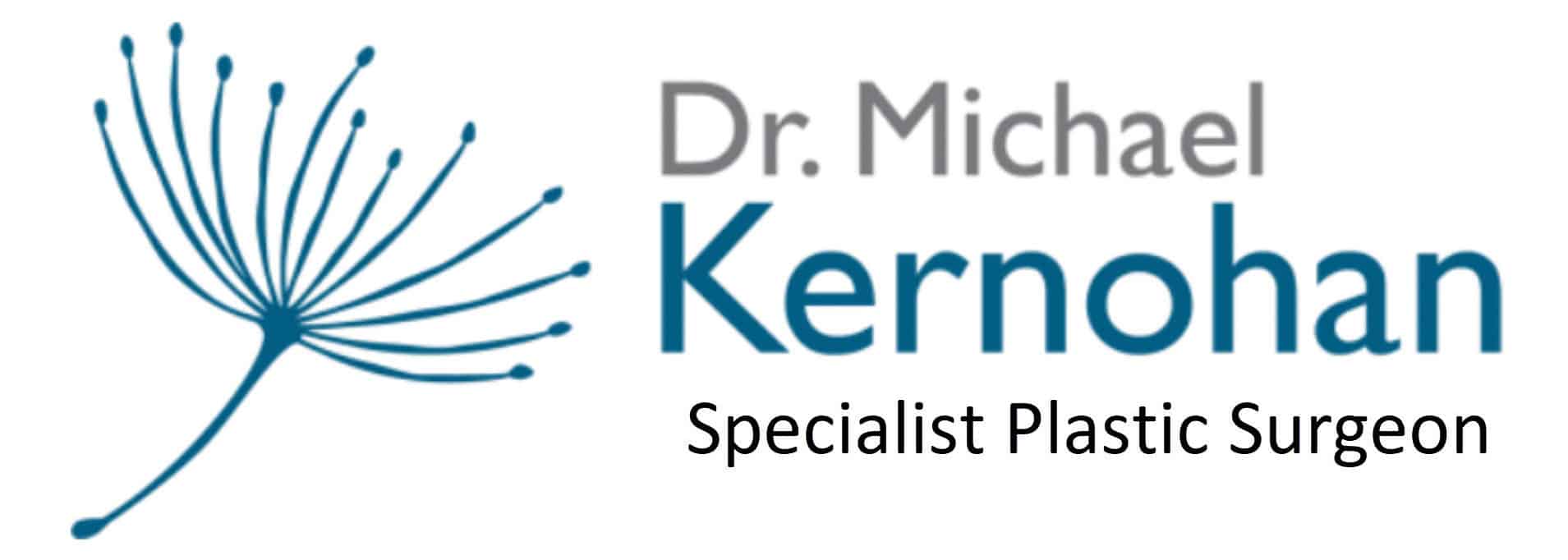Facial Nerve Surgery Sydney NSW – Reanimation and Static Surgery for Facial Paralysis in Sydney by Dr Kernohan
Facial nerve surgery is usually the treatment of choice for facial paralysis. Surgical decompression, facial nerve reconstruction, nerve transfer, nerve grafts, are a few surgical approaches that can be used to improve the outcomes of facial nerve disorders and help treat facial paralysis and Bells Palsy.
Australian Specialist Plastic Surgeon Dr Michael Kernohan performs a variety of facial reanimation surgeries to restore motor function to the facial muscles. Alternatively, static procedures might also be done to improve your facial symmetry and aesthetics.
Download Dr Michael Kernohan Facial Rejuvenation Guide

What Is the Facial Nerve?
The facial nerve is a very important cranial nerve. It controls your facial muscles. It’s involved in speech, chewing, smiling, moving the eyelids, and performing facial expressions. Facial nerve paralysis is a condition where the facial nerve completely or partially loses its function. It can be a result of trauma, stroke, or a viral infection.
Regardless of the cause, permanent facial nerve paralysis can cause a facial droop, facial asymmetry, eyelid drooping, crooked smile, and might reduce your ability to perform different facial expressions.
The facial nerve is one of 12 cranial nerves that transmit information between the brain and different parts of the body. It’s sometimes referred to as cranial nerve VII, or CN VII.
There is one facial nerve on each side of your face. On both sides, the facial nerve further branches in the temple area, in front of the ears, in the cheeks, and in the jaw region creating a fine network of nerves that coordinate your facial movements.
The main roles of the facial nerve include:
- Controlling mastication (chewing – it controls the lips but not the jaw muscles)
- Managing facial expressions – smiling, frowning, laughing, showing surprise, etc.
- Maintaining the general shape of your face at rest by controlling facial muscles tone
- Closing your eyelids – by controlling the eye muscles (called orbicularis oculi)
What Is Facial Nerve Paralysis?
Facial nerve paralysis is when the 7th cranial nerve stops functioning properly. The muscle tone and control are lost in the facial muscles – you can’t move your cheeks, close your eyelids, and make certain facial expressions.
Typically, facial nerve paralysis happens on a single side of the face. The muscles that are usually innervated by the damaged facial nerve will atrophy (become smaller) due to loss of function. This leads to facial asymmetry – your face will look uneven.
Causes of facial nerve problems include stroke, head trauma, surgical trauma (iatrogenic injury), and Bell’s palsy (explained below).
If you have permanent paralysis in your face, then facial nerve reconstructive surgery (also called facial reanimation or neurotisation) can help restore motor functions and facial expression abilities.
Reconstructive static surgery, on the other hand, will not bring back spontaneous movement but can lift the cheek and improve your appearance. However, other treatment options can improve the symmetry of your face and improve it cosmetically.

Symptoms of Facial Paralysis
If you have facial paralysis, you will probably have one or more of the following typical symptoms on the affected side of your face:
- Uneven looking face (facial asymmetry)
- Inability to close the eyelid, and subsequent eye dryness, irritation, and inflammation
- Loss or reduced control over facial musculature – You won’t be able to normally laugh, frown, and facially express your feelings
- You’ll have an uneven or crooked smile (your lips will be drooping on one side)
- You’ll have a droopy face at rest (on the affected side only)
- Inability to blink properly
- Uneven eye size
- Can’t chew properly or drink water without spilling
- Synkinesis – a condition where performing one facial expression leads to other undesired facial movements
Facial paralysis surgery by Dr Kernohan can restore some function in the facial musculature, reduce face asymmetry, and reduce facial droop.
What Causes Facial Nerve Paralysis
Facial nerve function can be affected by damage to any of the several facial nerve branches that supply the face musculature. Several causes might lead to facial nerve lesions and face paralysis:
- Stroke: A stroke, or cerebrovascular accident, can affect the facial nerve function and lead to problems with facial musculature
- Facial palsy: also called “Bell’s palsy”. This is usually considered a post-viral condition that causes inflammation of the facial nerve. Facial palsy usually resolves spontaneously without treatment. Antiviral therapy and steroid tablets are usually prescribed in the hope that they limit the damage. Sometimes, the facial nerve dysfunction caused by Bell’s palsy might persist, requiring surgical treatment. Any sign of recovery in the first week is normally a good sign
- Traumatic facial nerve injury: Any traumatic facial nerve lesion can cause facial paralysis. This includes lesions caused by surgery (iatrogenic injury) or planned cancer surgery and direct trauma. If the facial nerve is cut, it can be sometimes immediately repaired (primary repair). The two facial nerve stumps are attached and sutured together under an operating microscope and this can return good function. However, permanent paralysis can also be managed with facial reanimation surgical procedures – nerve graft, facial nerve decompression, regional muscle transfer, and others
- Facial Neuroma or Acoustic Neuroma: This is a slow-growing tumour that can arise in the facial nerve and unilateral hearing loss. Surgical exploration, tumour removal, and facial nerve reconstruction are usually the best way to treat facial neuroma
Benefits of Facial Nerve Surgery – What you can expect
The outcomes of facial nerve repair depend on the original injury and the performed procedure.
Expected outcomes after reanimation procedures include:
- More symmetric and coordinated facial expressions
- Restore motor abilities and facial function
- Restore ability to blink and close the eyes
- Improve eating and drinking abilities
Expected outcomes after static procedures include:
- Better facial symmetry – the paralysed side will look less droopy
- Better eye symmetry, and improved ability to close the eyes
- Reduced smile deformity – more symmetric mouth and lips
- Less eye irritation and inflammation
Surgery for Facial Nerve Paralysis
The treatment for facial nerve palsies includes several surgical techniques. Dr Kernohan might combine several techniques together to achieve the desired outcomes.
Surgeries for facial nerve paralysis can be classified into two large groups:
- Reanimation procedures: These are procedures that attempt to restore function in the facial muscles. The goal is to help you move your face muscles to smile, frown, and express moods. The aim is functional recovery and not just cosmetic improvement
- Static procedures: These procedures do not restore movement to the paralysed muscles. They just improve the cosmetic look. Face lifting and eyelid procedures can restore symmetry to your face, and reduce facial droop, but won’t restore movement.
Depending on what you need, Dr Kernohan will recommend one or more of the following facial paralysis procedures:
Facial Reanimation Procedures
These are plastic surgery facial procedures to repair the facial nerve itself, restoring muscle tone and control of the facial musculature:
- Primary nerve repair: If you have facial nerve trauma, and the nerve is cut, Dr Kernohan will attempt to directly re-attach the two distal nerve stumps together. Full functional recovery can be achieved with primary repair in many cases, however, some patients might only have partial recovery after their injury
- Facial nerve decompression: If a tumour (e.g. vestibular schwannomas or neuromas) is compressing the facial nerve, decompressive surgery is required. Dr Kernohan will work with a skull base surgeon (neuro-otologist) and a neurosurgeon to remove the tumour and relieve the compression on the facial nerve
- Hypoglossal nerve transfer surgery: This is when Dr Kernohan moves or “transfers” a healthy peripheral nerve that supplies the tongue, and re-routes it to provide nerve supply to the facial muscles. The transferred hypoglossal nerve will restore control over the facial musculature and decrease facial asymmetry. Improvement after hypoglossal nerve transfer surgery usually needs more than 6 months to be noticed
Other surgical procedures:
- Masseteric nerve transfer: This is a procedure that’s similar to hypoglossal nerve transfer, however, it uses the masseteric nerve. This is a peripheral nerve that supplies the masseter muscle, a cheek muscle that helps you chew. The masseter nerve is transferred and attached to the distal end of the injured facial nerve. It then sprouts over time and grows into the paralysed muscles to restore their function
- Cross-facial nerve graft: This is a procedure where Dr Kernohan connects the facial nerve on the healthy side of your face to the one on the paralysed side of your face. So when the healthy facial nerve is stimulated, the paralysed side is stimulated as well. When your right face smiles, your left face smiles as well. To do this, Dr Kernohan uses a nerve graft – usually the sural nerve graft (a small nerve supplying a patch of skin on the side of the foot). The grafted never grows slowly and can eventually restore coordinated movement between the two sides of the face
- Eyelid re-innervation: Similar to the cross-facial nerve graft technique. Nerve branches are rerouted from the healthy side to the paralysed side to restore coordinated eyelid movement
What happens if the facial nerve can’t be repaired?
If the facial nerve cannot be repaired, and the old paralysed muscles cannot be restored, then new healthy muscles can be transferred from other areas of the body. It needs to be implanted in the face and the artery and vein supplying it reconnected to facial or neck blood vessels to allow it to come back to life and reanimate it.
Free microvascular muscle transfer surgeries can include:
- Gracilis muscle transplant: The Gracilis muscle is a small muscle of the inner thigh. Dr Kernohan will implant healthy Gracilis muscle tissue into the paralysed side, providing it with blood supply and nerve supply to thrive and function. With time, you should be able to contract the transplanted Gracilis muscle, moving the paralysed side of your face. The goal is to restore facial expressions and muscle tone on the affected side
- Temporalis muscle transfer: Also called a sliding Temporalis myoplasty. The Temporalis muscle is a flat muscle that extends from the temple to the jaw on each side of the face. The muscle tendon can be relocated and repositioned in the mid-face and lip region. This way, when the temporalis muscle contracts, it can move the face and allow you to perform certain facial expressions like smiling
- Eyelid muscle transplantation: If you’ve had eyelid paralysis for a long time, the muscles around your eyes will likely be atrophied. A muscle transplant is taken from the tin skin of the neck and grafted around the eye to provide some eyelid movement
Facial Static Procedures
These procedures do NOT restore motor function, however, they can address specific problems associated with facial nerve paralysis, like eye irritation, facial sagging and facial drooping.
People with facial nerve paralysis sometimes lose the ability to close the eye on the affected side of the face. This can lead to chronic eye dehydration, irritation, and infections. Some patients wear an eyepatch for eye protection. Eyelid surgery might be attempted to allow the eye to close:
- Upper eyelid weights: Small gold or platinum weights are inserted into the upper eyelid to make it heavier. This will allow the eye to close better
- Lower eyelid tightening: Facial nerve palsy can cause the lower eyelid to loosen and droop. Eyelid tightening can be attempted to better close your affected eye
Facial asymmetry can also develop due to facial nerve paralysis. The loss of nerve supply leads to muscle atrophy and the paralysed side will appear droopy and lax. The strong side of the face can cause the weak side to be pulled across the midline, like taking the springs off half of a trampoline. Your eyelids, cheeks, and skin will drop down significantly compared to the non-paralysed side. For this, facial symmetry can be restored with:
- Facelift procedure for Facial Paralysis: A facelift or meloplasty is a surgery that pulls the deep layers of the face upwards, and fixes them in a better position. This counteracts the droopiness caused by facial nerve paralysis.
Synkinesis Surgery
Synkinesis is a condition that sometimes occurs as a complication of some facial nerve lesions. It’s when another part of the face moves when you attempt to make a certain facial expression. Procedures to treat Synkinesis include:
- Anti-wrinkle injections: Can block motor nerves supplying the abnormally moving part of your face
- Selective myomectomy: A surgical procedure to cut or take out the muscle contracting abnormally
- Selective neurolysis: A procedure to remove the nerve that’s malfunctioning in the face, functionally paralysing the contracting muscles.
How to Prepare for Facial Nerve Surgery
During your first consultation, Dr Kernohan will ask you questions about your condition and assess your general health. You should expect to answer questions like:
- Have you been diagnosed with facial nerve paralysis?
- Have you had any previous head or neck surgery?
- Do you take any medications or have any chronic medical conditions?
- Have you had any head or neck injuries?
- Have you had any recent infections?
If you’ve already been previously diagnosed with facial nerve palsy, make sure you bring all the relevant tests, images, and reports that explain your condition to the consultation.
Dr Kernohan might request a few more medical tests to assess the function of your facial muscles and nerves. These can include nerve conduction studies, electromyography, and imaging studies.
Based on your results, Dr Kernohan will determine if you are suited to static procedures or facial reanimation surgery. You will discuss the risks and benefits of these procedures to determine the best surgery for you.
Dr Kernohan may recommend eyelid surgery, muscle transplant, nerve transfer procedure, or any combination of these.
What Causes Facial Palsy Video
The Day of Facial Nerve Surgery
On the day of your facial nerve repair procedure, you should arrive with an empty stomach. Dr Kernohan will let you know if you should stop blood-thinning medications before your procedure.
Some of the facial nerve surgeries are day procedures. This means that you won’t have to spend the night at the hospital. More extensive surgeries, like facelift and muscle transplant, might require that you stay a night or two at the hospital.
Facial nerve procedures can be done under local anaesthesia or general anaesthesia, depending on the type of procedure planned.
How Is Recovery After Facial Nerve Surgery?
Recovery after facial nerve plastic surgery is hard to predict. In general, the surgery will take 2 weeks to heal and for most bruising to resolve.
You can usually return to work 2 to 5 days after your procedure. This depends on the type of facial procedure you have. Recovery may be longer with larger surgery like a facelift or facial muscle transfers.
You may be referred to a Physiotherapist to get facial retraining exercise after surgery. These are exercises that will help you better control your facial muscles after facial nerve reconstruction and facial muscle transfer.
Functional and cosmetic outcomes with reanimation procedures might need 12 months or longer to reach their full potential. During this time, the implanted nerves and/or muscles will grow into their new functions and your brain will learn how to better control them.
Static surgeries, like eyelid lift, eyelid loading, and facelift usually provide fast results. The improvement will be apparent immediately after your facial nerve surgery.
Risks and Complications of Facial Nerve Surgery
All surgical procedures entail a certain level of risk. At the same time, complications can occur during or after the surgical intervention was performed. Please choose your plastic surgeon with care to minimise your risks.
Find out more details about plastic surgery risks here.
Facial Nerve Surgery Cost – How Much Is Facial Nerve Surgery Sydney?
The cost of facial nerve repair is hard to estimate. It completely depends on the type of facial concerns you have and the surgery you are getting.
Nerve transfer surgery, facial nerve decompression, muscle transplant procedures, facelifts, eyelid procedures, and regional muscle transfer all incur different costs. Static techniques are generally less demanding and costly compared to facial reanimation techniques.
Have a look at Dr Kernohan’s prices page to get an idea about the costs involved with surgery.
Please call or contact his team for a price estimate.

Does Medicare Cover Facial Nerve Surgery?
Medicare and insurance usually help cover facial nerve surgery. If you meet the Medicare criteria, you should be eligible for a partial rebate. Medicare coverage is required to get a subsidy from your health fund if you have the right level of cover. Check out information on Medicare item numbers here.
It’s also important to know that there is a Facial Surgery payment plan and medical financing options available to help you fund the surgery.

Facial Nerve Surgery FAQs
How long does it take for facial nerves to repair after surgery?
- This depends on the type of facial repair surgery you’re undergoing. On average, nerve healing after nerve grafting can take around 12 months.
Can facial nerve damage be repaired?
- Yes. Static procedures and facial reanimation procedures can successfully improve the outcomes associated with facial nerve injury and damage. They can cosmetically improve your face and partially or fully restore motor functions to the facial muscles.
How much does facial reanimation surgery cost?
- The cost of reanimation surgery depends on the type. Cross-facial nerve grafting, regional muscle transfer, facial nerve decompression surgery, and free-muscle transfer have different costs. This can be further discussed during your first consultation with Dr Kernohan. Visit the surgery pricing page for more information
What doctor treats facial nerves?
- Facial nerve paralysis can be surgically treated by an ENT surgeon or specialist plastic surgeon. These two types of surgeons specialize in facial nerve grafting and free-muscle transfer to restore facial function. Specialist Plastic Surgeons in particular use advanced surgical techniques to ensure the best cosmetic outcomes possible after surgery. Many reconstructive facial procedures are usually performed by plastic surgeons and procedures involving the middle ear or brain by ENT or neurosurgeons.
What would happen if the facial nerve is damaged?
- Facial nerve lesions sometimes heal spontaneously particularly if the nerve has only been bruised. However, permanent facial nerve damage might require surgery to get the best outcome. Reanimation surgery, with free microvascular muscle transfer and nerve transfer, are the top methods to deal with facial nerve paralysis.
What is reanimation surgery?
- Reanimation surgery is a type of facial nerve surgery that aims to restore motor abilities in the paralysed side. It includes free-muscle transfer, Temporalis muscle transfer, Masseter nerve transfer, Gracilis muscle transfer, Hypoglossal nerve transfer, and Cross-facial nerve graft. After facial reanimation surgery, you should be able to better move the affected side and perform facial expressions.
How do you fix facial nerve paralysis?
- Facial nerve decompression, reanimation procedures, and static procedures can help counteract the effects of facial nerve paralysis.
Can you reverse facial paralysis?
- Sometimes, it’s possible to reverse the effects of facial paralysis with facial reanimation surgery, which includes Masseter nerve transfer, Gracilis muscle transfer, Hypoglossal nerve transfer, and Cross-facial nerve graft. These are procedures that allow you to move your facial muscles again after facial nerve palsy or paralysis.
What does the facial nerve supply?
- The facial nerve mainly supplies muscles that close the eyes and the muscles of facial expression.
What is the hypoglossal nerve?
- The hypoglossal nerve is a cranial nerve that moves the tongue.
What is temporalis tendon transfer?
- This is a facial reanimation procedure done to treat facial nerve paralysis. Also called a sliding temporalis myoplasty. It involves moving the temporalis muscle tendon (which is a muscle on the side of the face) and repositioning it to the lip area. This can partially restore your ability to move the paralysed side of your mouth.
Can plastic surgery fix Bell’s palsy?
- Facial Plastic surgery Sydney can help deal with the outcomes of facial palsy. Nerve grafting procedures, muscle transfer procedures, and other facial reanimation procedures and static procedures all fall within the field of plastic and reconstructive surgery.
Can you make me smile again?
- This is the most popular question of all. While we would love to say yes, it isn’t always possible but the sooner you seek advice from a specialist plastic surgeon who performs this surgery the better chance you have.
When is the best time to see a specialist?
- After 12-18 months of inactivity in the muscles in your face, they degenerate and will not work again. Before that time, they can be re-innervated (reneurotised) by nerve transfers. Timing is everything – seek an urgent appointment with a facial nerve surgeon.
Further Reading and Medical References on Facial Nerve Surgery & Facial Paralysis Surgery
- Reanimation Surgery for Facial Nerve Paralysis
- Facial Nerve Repair – StatPearls
- Facial Nerve Center – Facial Plastic & Reconstructive Surgery – UCLA Head and Neck Surgery – Los Angeles, CA
- Efficacy of surgical repair for the functional restoration of injured facial nerve – BMC Surgery
- Dynamic Reconstruction for Facial Nerve Paralysis: Overview, Anatomy of the Facial Nerve, Etiology in Prognosis and Treatment
- A Detailed Look at Facial Nerve Repair Options in Austin
- Cross Facial Nerve Graft
- Facial Nerve Center | Otolaryngology — Head & Neck Surgery | Stanford Medicine





